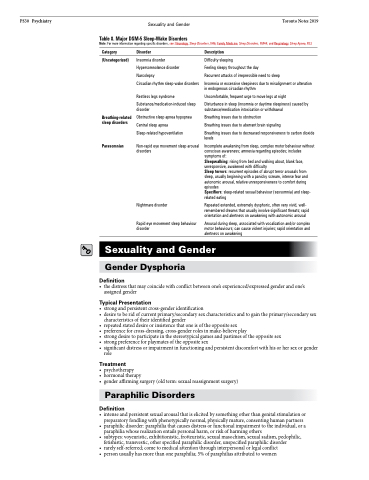Page 1194 - TNFlipTest
P. 1194
PS30 Psychiatry
Sexuality and Gender Toronto Notes 2019
Table 8. Major DSM-5 Sleep-Wake Disorders
Note: For more information regarding specific disorders, see: Neurology, Sleep Disorders, N46; Family Medicine, Sleep Disorders, FM44; and Respirology, Sleep Apnea, R32
Category
(Uncategorized)
Breathing-related sleep disorders
Parasomnias
Disorder
Insomnia disorder
Hypersomnolence disorder
Narcolepsy
Circadian rhythm sleep-wake disorders
Restless legs syndrome
Substance/medication-induced sleep disorder
Obstructive sleep apnea hypopnea Central sleep apnea
Sleep-related hypoventilation
Non-rapid eye movement sleep arousal disorders
Nightmare disorder
Rapid eye movement sleep behaviour disorder
Description
Difficulty sleeping
Feeling sleepy throughout the day
Recurrent attacks of irrepressible need to sleep
Insomnia or excessive sleepiness due to misalignment or alteration in endogenous circadian rhythm
Uncomfortable, frequent urge to move legs at night
Disturbance in sleep (insomnia or daytime sleepiness) caused by substance/medication intoxication or withdrawal
Breathing issues due to obstruction
Breathing issues due to aberrant brain signaling
Breathing issues due to decreased responsiveness to carbon dioxide levels
Incomplete awakening from sleep, complex motor behaviour without conscious awareness; amnesia regarding episodes; includes symptoms of:
Sleepwalking: rising from bed and walking about, blank face, unresponsive, awakened with difficulty
Sleep terrors: recurrent episodes of abrupt terror arousals from sleep, usually beginning with a panicky scream, intense fear and autonomic arousal, relative unresponsiveness to comfort during episodes
Specifiers: sleep-related sexual behaviour (sexsomnia) and sleep- related eating
Repeated extended, extremely dysphoric, often very vivid, well- remembered dreams that usually involve significant threats; rapid orientation and alertness on awakening with autonomic arousal
Arousal during sleep, associated with vocalization and/or complex motor behaviours; can cause violent injuries; rapid orientation and alertness on awakening
Sexuality and Gender
Gender Dysphoria
Definition
• thedistressthatmaycoincidewithconflictbetweenone’sexperienced/expressedgenderandone’s assigned gender
Typical Presentation
• strongandpersistentcross-genderidentification
• desiretoberidofcurrentprimary/secondarysexcharacteristicsandtogaintheprimary/secondarysex
characteristics of their identified gender
• repeatedstateddesireorinsistencethatoneisoftheoppositesex
• preferenceforcross-dressing,cross-genderrolesinmake-believeplay
• strongdesiretoparticipateinthestereotypicalgamesandpastimesoftheoppositesex
• strongpreferenceforplaymatesoftheoppositesex
• significantdistressorimpairmentinfunctioningandpersistentdiscomfortwithhisorhersexorgender
role
Treatment
• psychotherapy
• hormonaltherapy
• genderaffirmingsurgery(oldterm:sexualreassignmentsurgery)
Paraphilic Disorders
Definition
• intenseandpersistentsexualarousalthatiselicitedbysomethingotherthangenitalstimulationor preparatory fondling with phenotypically normal, physically mature, consenting human partners
• paraphilicdisorder:paraphiliathatcausesdistressorfunctionalimpairmenttotheindividual,ora
paraphilia whose realization entails personal harm, or risk of harming others
• subtypes: voyeuristic, exhibitionistic, frotteuristic, sexual masochism, sexual sadism, pedophilic,
fetishistic, transvestic, other specified paraphilic disorder, unspecified paraphilic disorder
• rarelyself-referred;cometomedicalattentionthroughinterpersonalorlegalconflict
• personusuallyhasmorethanoneparaphilia;5%ofparaphiliasattributedtowomen


